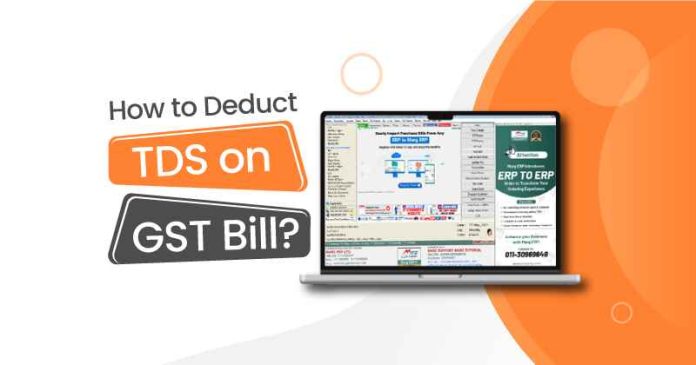Tax Deducted at Source (TDS) is an essential aspect of the Indian taxation system, designed to collect tax at the very source of income. Under the Goods and Services Tax (GST) regime, TDS provisions are applicable to certain specified transactions. While making the payment, deduct TDS and deposit it with the government using the GST portal. The deducted TDS must be reported in the TDS return, and the supplier can claim the credit of this amount in their GST return.
What is TDS?
TDS stands for Tax Deducted at Source. It’s a method where tax is deducted at the point of income generation. This ensures that taxes are collected on time and reduces the chances of tax evasion. The tax deducted is then paid to the government by the entity that deducts the tax.
What is GST?
GST stands for Goods and Services Tax. It is a comprehensive indirect tax on the supply of goods and services in India, replacing multiple indirect taxes previously levied by the central and state governments. GST is designed to simplify the taxation system and create a unified market.
TDS Under GST
Under the GST regime, specific provisions have been made for TDS to be deducted by certain entities. The objective is to track transactions and ensure that taxes are collected efficiently. As per the GST law, TDS is to be deducted by:
- Departments or establishments of the Central or State Government.
- Local authorities.
- Governmental agencies.
- Persons or categories of persons notified by the Government on the recommendations of the GST Council.
How to Calculate TDS on GST Bill

When is TDS on GST Applicable?
TDS under GST is applicable when the total value of supply under a contract exceeds INR 2,50,000. It is important to note that this threshold limit is for a single contract and not for aggregate supplies.
TDS Rate Under GST
The TDS rate under GST is 2% of the payment made to the supplier. This 2% is split into:
- 1% CGST (Central Goods and Services Tax)
- 1% SGST (State Goods and Services Tax)
For inter-state supplies, the TDS rate is 2% IGST (Integrated Goods and Services Tax).
Steps to Calculate TDS on GST Bill
- Identify the Contract Value: Check if the total value of supply under a contract exceeds INR 2,50,000.
- Verify GST Registration: Ensure that both the deductor (person deducting TDS) and the deductee (supplier) are registered under GST.
- Determine the Amount to be Paid: Calculate the amount to be paid to the supplier, excluding GST.
- Calculate TDS: Deduct TDS at the rate of 2% on the amount payable to the supplier, excluding GST.
- Deposit TDS: Deposit the deducted TDS with the government within the specified time frame.
- File TDS Returns: File TDS returns in Form GSTR-7 and issue a TDS certificate in Form GSTR-7A.
Example of How to Calculate TDS on GST Bill
Let’s understand how to calculate TDS on a GST bill with an example.
Example Scenario
Suppose a government department enters into a contract with a supplier for goods worth INR 3,00,000. The applicable GST rate is 18%.
Step-by-Step Calculation
- Contract Value: INR 3,00,000
- GST Amount: 18% of INR 3,00,000 = INR 54,000
- Total Invoice Value: INR 3,00,000 + INR 54,000 = INR 3,54,000
- Amount Excluding GST: INR 3,00,000
- TDS Calculation: 2% of INR 3,00,000 = INR 6,000
- CGST (1%): INR 3,000
- SGST (1%): INR 3,000
The TDS to be deducted is INR 6,000, and the payment to the supplier after deducting TDS would be:
Payment to Supplier: INR 3,54,000 – INR 6,000 = INR 3,48,000
Depositing and Filing TDS
After deducting TDS, the government department must deposit the TDS amount of INR 6,000 with the government. The TDS deducted should be deposited by the 10th of the following month. Additionally, the department must file TDS returns in Form GSTR-7 and issue a TDS certificate in Form GSTR-7A to the supplier.
Why TDS Compliance is Important?
Following TDS rules under GST is crucial for businesses and government entities to avoid penalties and legal issues. Here are some key points to ensure compliance:
- Timely Deduction and Deposit: Ensure that TDS is deducted and deposited on time.
- Accurate Calculation: Verify the accuracy of TDS calculations.
- Regular Filing of Returns: File TDS returns (GSTR-7) on time to avoid penalties.
- Issuance of TDS Certificates: Provide TDS certificates (GSTR-7A) to the supplier.
What are the Benefits of TDS on GST?
TDS on GST offers several benefits:
For the Government
- Efficient Tax Collection: TDS ensures timely tax collection.
- Tracking Transactions: Helps track high-value transactions and reduce tax evasion.
- Revenue Growth: Contributes to steady government revenue growth.
For Taxpayers
- Transparency: Creates a transparent tax environment.
- Credit Availability: Suppliers can claim TDS credit against their tax liabilities.
- Compliance: Promotes compliance with tax laws.
Challenges in Implementing TDS on GST Bills
While TDS on GST offers advantages, it also presents some challenges:
Complex Calculations
Calculating TDS on GST can be complex, especially with multiple contracts and different GST rates. Accurate calculations are necessary to avoid discrepancies and penalties.
Compliance Burden
Filing TDS returns and issuing certificates require meticulous record-keeping and adherence to deadlines, which can be burdensome for small businesses and government departments.
Technological Challenges
Ensuring seamless integration of TDS processes with existing accounting and taxation software can be challenging. Technological upgrades may be required for efficient TDS calculations and filings.
Conclusion
Deducting TDS on GST bills is an important compliance requirement under the GST regime. Understanding the process, calculating TDS accurately, and adhering to compliance norms are essential for businesses and government entities. By following the guidelines provided in this blog, taxpayers can ensure smooth and efficient TDS deductions on GST bills, contributing to a transparent and robust taxation system.
Read More:-
- What is GSTR 9 and How a Pharmacy Billing Software Keeps You GST Compliant. Managing GST compliance can be tricky for pharmacy owners, especially with multiple purchase bills, supplier returns, and input tax credit tracking. GSTR-9, the annual GST return, brings all these details together for a complete yearly summary. Understanding it, especially… Read more: What is GSTR 9 and How a Pharmacy Billing Software Keeps You GST Compliant.
- What is an Invoice Management System and How Marg ERP Keeps You GST Compliant. GST is going through a lot of changes and evolutions in recent months from GST 2.0 announced on 3rd September 2025 (effective from 22nd September 2025) to GSTR-9 Table 8A update in IMS (Invoice Management System) announced on 17th… Read more: What is an Invoice Management System and How Marg ERP Keeps You GST Compliant.
- Section 122 of CGST Act Simplified: Stay Penalty-Free with Marg Billing Software Section 122 of the Central Goods and Services Tax (CGST) Act deals with penalties and offences under GST law. It is aimed at curbing non-compliance such as false invoicing, mis‐claiming input tax credit (ITC), suppression of turnover, failing to… Read more: Section 122 of CGST Act Simplified: Stay Penalty-Free with Marg Billing Software
- Section 46 of the CGST Act & the GST 2.0 Era: Why Compliance Can’t Wait Compliance is the most important part of today’s business. It enhances company’s reputation, minimises financial and regulatory risks, and improves overall operations and financial management. Therefore, you need to have a solid understanding of Sections and Clauses related to… Read more: Section 46 of the CGST Act & the GST 2.0 Era: Why Compliance Can’t Wait
Frequently Asked Question
What is TDS on GST?
TDS on GST stands for Tax Deducted at Source under the Goods and Services Tax system. It means a certain percentage of the payment made to suppliers is deducted as tax and paid to the government. This helps in the timely collection of taxes and ensures that there is less tax evasion. The deducted tax is then deposited with the government by the deductor.
Who needs to deduct TDS on GST?
Certain entities are mandated to deduct TDS under GST. These include departments or establishments of the Central or State Government, local authorities, government agencies, and other specified persons notified by the government. These entities must deduct TDS when making payments to suppliers if the total value of supply under a contract exceeds INR 2,50,000.
When should TDS be deducted under GST?
TDS under GST should be deducted when the total value of supply under a single contract exceeds INR 2,50,000. The deduction is made at the time of payment or when the payment is credited to the supplier’s account, whichever is earlier. This ensures that the tax is collected at the source of the income.
What is the rate of TDS on GST?
The rate of TDS under GST is 2%. This 2% is divided into 1% Central GST (CGST) and 1% State GST (SGST) for intra-state supplies. For inter-state supplies, the TDS rate is 2% Integrated GST (IGST). This rate is applied to the amount payable to the supplier, excluding GST.
How is TDS calculated on a GST bill?
To calculate TDS on a GST bill, first, identify the contract value excluding GST. If this value exceeds INR 2,50,000, then TDS should be deducted at 2% on the payment amount, excluding GST. For example, if the contract value is INR 3,00,000 and GST is INR 54,000, TDS is calculated on INR 3,00,000. So, TDS would be 2% of INR 3,00,000, which is INR 6,000.
How to deposit TDS on GST?
The deducted TDS must be deposited with the government by the 10th of the next month. This can be done through the GST portal. The deductor needs to file Form GSTR-7, which is a return form for TDS. The amount deducted must be paid to the government using the electronic cash ledger on the GST portal.
What is Form GSTR-7?
Form GSTR-7 is a return form that must be filed monthly by entities deducting TDS under GST. It includes details of the TDS deducted, TDS paid, and any TDS liability payable. The form must be submitted by the 10th of the following month. Filing this form is crucial for maintaining compliance and avoiding penalties.
How to issue a TDS certificate?
After deducting TDS, the deductor must issue a TDS certificate to the supplier in Form GSTR-7A. This certificate provides details of the amount paid and the TDS deducted. The certificate must be issued within five days of filing Form GSTR-7. The supplier can use this certificate to claim TDS credit.
Can suppliers claim TDS credit?
Yes, suppliers can claim the TDS credit that appears in their electronic cash ledger. This credit can be used to pay their output tax liability. The supplier needs to reconcile the TDS credit shown in their ledger with the TDS certificates issued by the deductor.
What happens if TDS is not deducted?
If TDS is not deducted as required, the deductor may face penalties, interest, and other legal consequences. Non-compliance can result in financial losses and damage to the entity’s reputation. Therefore, it is crucial for deductors to adhere to TDS provisions under GST to avoid these issues. Timely deduction and deposit of TDS ensure smooth compliance with GST regulations.
























